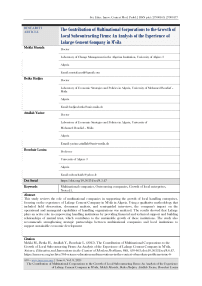The Contribution of Multinational Corporations to the Growth of Local Subcontracting Firms: An Analysis of the Experience of Lafarge Cement Company in M’sila
Автор: Mekki M., Betka H., Attallah Y., Bouchair L.
Журнал: Science, Education and Innovations in the Context of Modern Problems @imcra
Статья в выпуске: 6 vol.8, 2025 года.
Бесплатный доступ
This study reviews the role of multinational companies in supporting the growth of local handling enterprises, focusing on the experience of Lafarge Cement Company in M'sila in Algeria. Using a qualitative methodology that included field observation, document analysis, and semi-guided interviews, the company's impact on the operational and managerial capabilities of handling organizations was analyzed. The results showed that Lafarge plays an active role in empowering handling institutions by providing financial and technical support and building relationships of mutual trust, which contributes to the sustainable growth of these institutions. The study also recommends strengthening strategic partnerships between multinational companies and local institutions to support sustainable economic development.
Multinational companies, Outsourcing companies, Growth of local enterprises, Nvivo11
Короткий адрес: https://sciup.org/16010784
IDR: 16010784 | DOI: 10.56334/sei/8.6.47
Текст научной статьи The Contribution of Multinational Corporations to the Growth of Local Subcontracting Firms: An Analysis of the Experience of Lafarge Cement Company in M’sila
RESEARCH ARTICLE The Contribution of Multinational Corporations to the Growth of Local Subcontracting Firms: An Analysis of the Experience of Lafarge Cement Company in M’sila Mekki Mustafa < Doctor Laboratory of Change Management in the Algerian Institution, University of Algiers 3 Algeria Email: Betka Hadjira \ \ \ Doctor Laboratory of Economic Strategies and Policies in Algeria, University of Mohamed Boudiaf – Msila Algeria Email: Attallah Yacine Doctor Laboratory of Economic Strategies and Policies in Algeria, University of Mohamed Boudiaf – Msila Algeria Email: / Bouchair Louiza Professor University of Algiers 3 Algeria Email: Doi Serial Keywords Multinational companies, Outsourcing companies, Growth of local enterprises, Nvivo11. Abstract This study reviews the role of multinational companies in supporting the growth of local handling enterprises, focusing on the experience of Lafarge Cement Company in M'sila in Algeria. Using a qualitative methodology that included field observation, document analysis, and semi-guided interviews, the company's impact on the operational and managerial capabilities of handling organizations was analyzed. The results showed that Lafarge plays an active role in empowering handling institutions by providing financial and technical support and building relationships of mutual trust, which contributes to the sustainable growth of these institutions. The study also recommends strengthening strategic partnerships between multinational companies and local institutions to support sustainable economic development Citation Mekki M., Betka H., Attallah Y., Bouchair L. (2025). The Contribution of Multinational Corporations to the Growth of Local Subcontracting Firms: An Analysis of the Experience of Lafarge Cement Company in M’sila. Science, Education and Innovations in the Context ofModern Problems, 8(6), 450-463; doi:10.56352/sei/8.6.47.
(SEI) by IMCRA - International Meetings and Journals Research Association (Azerbaijan). This is an open access article under the CC BY license .
The present study aims to explore the role of Lafarge Cement in M’Sila in supporting the growth of its local subcontractors. The research focuses on examining how this multinational corporation contributes to the development of local firms by strengthening their operational and managerial capabilities, and by providing a supportive environment for sustainable growth. The study also seeks to identify the factors that make Lafarge an effective partner in this growth and to analyze the cooperation mechanisms between the company and its subcontractors in practical terms.
The study is guided by several key questions: Does Lafarge Cement in M’Sila contribute to the growth of selected local subcontracting firms? What are the motives and factors that make the company an active partner in this growth? How do the company’s contributions take shape in practice? These questions are of particular importance as they shed light on the role of multinational corporations in promoting sustainable development among local enterprises and offer conceptual frameworks for understanding how this growth is achieved through strategic partnerships.
The research is based on three main hypotheses. The first assumes that Lafarge has a positive and tangible impact on the growth of local subcontractors. The second suggests that the company provides continuous attention and support to these firms. The third hypothesis proposes that mutual trust between Lafarge and its subcontractors plays a central role in enhancing their performance and development. These hypotheses aim to clarify the dimensions of cooperation between multinational corporations and local firms, and to assess the extent to which such partnerships influence local economic development.
This study adopts the field case study method, which allows for in-depth analysis of the phenomenon from multiple perspectives. A variety of data collection tools were used to ensure accuracy and reliability, including field observations, document analysis, and semi-structured interviews with relevant stakeholders. For systematic qualitative data analysis, the study employed Nvivo 11 software, which enables the extraction of patterns and trends with precision. The sample consists of three purposefully selected subcontracting firms that have had ongoing contracts with Lafarge Algeria for more than five years. Their growth was tracked through changes in workforce size and number of branches.
The significance of this study lies in its ability to provide a comprehensive view of the role multinational corporations play in driving the growth of local firms in developing economies. These corporations contribute advanced technologies and managerial expertise, which enable local subcontractors to improve their competitiveness and enhance their sustainability. Thus, the study offers an important academic contribution to understanding how sustainable economic development can be achieved through effective partnerships between multinational and local firms.
2. Previous Studies
1. Oladimeji, Abosede, Eze, & Akanni (2018) This study explores the role of subcontracting in improving the performance of local firms in Nigeria through collaborative relationships with multinational corporations. The findings reveal that subcontracting between global firms and local contractors enhances both economic and technological performance. It helps reduce costs and increase productivity. Additionally, such partnerships contribute to developing managerial and technical capabilities among local contractors.
2. Robert (2024) This study examines the impact of multinational corporations on local enterprises in Sierra Leone by reshaping economic dependency relationships. The study indicates that global firms, through strategies of cooperation and resource sharing, may contribute to the growth of local companies. However, this occurs within a context of dependency that, in some cases, results in unbalanced relationships.
3. El-Kadi (2024) This research analyzes the role of major Chinese corporations, such as Huawei and ZTE, in transferring technology to North African countries, including Algeria. It evaluates the influence of these companies on local market development through the technologies they introduce. The study concludes that while some knowledge and technology are transferred, these companies offer limited opportunities for local learning, leading to a dependency on Chinese technologies.
4. Ghomari (2020) This study reviews the effect of upgrading programs in enhancing the competitiveness of Algerian enterprises in local and international markets. The results show that firms participating in such programs improve their performance across areas such as productivity, marketing, and management, thus strengthening their overall competitiveness.
5. Issac et al. (2020) This study examines the growing role of multinational corporations in supporting local economies in developing countries through investment and the transfer of technology and knowledge. It focuses on how global firms help grow local enterprises across various sectors by offering access to advanced technologies and training opportunities.
3. Conceptual Framework of the Study
These studies highlight the role of multinational corporations in supporting the growth of local firms, aligning with the objectives of the present research, which examines Lafarge Cement’s contribution to the development of subcontracting firms in M’Sila. For instance, Oladimeji et al. (2018) emphasize that subcontracting with global corporations improves the performance of local contractors by reducing costs and boosting productivity. Robert (2024) also stresses how multinational firms reshape local economic relations, offering a framework to understand how Lafarge may be contributing to improving the infrastructure and operational systems of its local partners.
On another note, El-Kadi (2024) discusses the impact of knowledge and technology transfer on strengthening local technological capacity, which reflects the potential role of Lafarge in supporting technological growth. In line with this, Ghomari (2020) highlights the importance of upgrading programs in improving competitiveness. Finally, Issac et al. (2020) explain how global companies foster local partnerships through knowledge and technology, which helps clarify the mechanisms through which such corporations support local contractors across different domains.
Within this context, industrial subcontracting appears as a strategic mechanism that supports the development of local enterprises. It is based on contractual cooperation between multinational corporations and specialized local firms (Debbouche & Berri, 2017). Although subcontracting refers to an arrangement where a major company delegates part or all of its production or service-related tasks to a local firm under a specified contract—while retaining final responsibility (Azirou, 2016)—it facilitates specialization, cost reduction, and quality improvement. It also creates opportunities for transferring technical and managerial expertise, thereby strengthening the competitiveness and growth of local firms (Khouriba & Yaouhi, 2020).
Moreover, the transfer of technology and knowledge is a core element in boosting the capabilities of local enterprises. However, the effectiveness of this process depends on the ability of local firms to absorb and apply the transferred knowledge. Some studies report cases of technological dependency that limit genuine local learning, particularly with regard to certain Chinese companies operating in North Africa (El-Kadi, 2024). Therefore, it becomes essential to develop effective mechanisms for knowledge transfer that enable local firms to independently build their technical and managerial capacities, ensuring long-term sustainability and increased competitiveness (Ghomari, 2020).
Furthermore, literature emphasizes the importance of trust-based cooperative relationships between multinational corporations and local firms. Trust is seen as a critical factor in achieving sustainable growth for subcontracting firms. It enables broader cooperation, strengthens mutual commitment, and enhances stability. This, in turn, increases the chances for local firms to access more and better business opportunities (Robert, 2024). Nonetheless, such relationships are not without challenges. Some studies point to patterns of dependency that may compromise the autonomy of local firms. This calls for in-depth analysis to ensure balanced and mutually beneficial partnerships (Robert, 2024).
3. Methodological Framework of the Study
The researcher and thinker Theodore H. Moran argues that studying the impact of multinational corporations on local enterprises is more complex than it may appear at first glance. He suggests that addressing such issues requires a shift from a macro-level view to a micro-level approach. This is achieved through individual case examination, using the case study method (Moran, 1994). Although this method limits generalizability, it is well-suited for deep exploration of phenomena. It enables a comprehensive understanding of both horizontal and vertical dimensions (Ben Jekhdal, 2019).
The population of this study includes all subcontracting firms operating under Lafarge Algeria, a branch of a leading multinational company in the production and marketing of cement, aggregates, and ready-mix concrete. This company is known for its large scale and wide geographic presence, employing about 75,000 workers across 80 countries. The Algerian branch alone includes around 2,200 direct employees and approximately 3,300 subcontracted workers.
To define the sample, specific criteria were applied. These included a minimum subcontracting duration of five years and representation across various sectors such as production, maintenance, and services. These conditions ensured that the sample reflected the diversity within the study population. The selected firms were also required to have a defined management structure and a formal headquarters to enable data collection. Furthermore, the owners had to agree to participate actively in the research. Based on these criteria, three subcontracting firms were selected. Their workforce growth was analyzed from the time they signed their first contract with Lafarge Cement in M’Sila until the end of 2020.
The study used a variety of tools to collect reliable and comprehensive data about the phenomenon. This mixed approach ensured a deeper understanding (Ben Jekhdal, 2019). Field observation was conducted to follow the realtime development and expansion of the subcontractors. Document analysis included data and official records from the factory, internal publications of the company, and materials provided by the selected subcontracting firms. In addition, semi-structured interviews were conducted. These interviews combined closed and open-ended questions, allowing for precise data collection while giving participants space to express their views freely. A structured interview guide was used to ensure focus on the study’s key themes.
In terms of data analysis tools, the case study method primarily relies on qualitative research rather than quantitative techniques. The outputs are usually expressed through descriptive language. The goal is to document and interpret observed realities using words rather than numbers (Ben Jekhdal, 2019). However, some modern software programs allow for a more structured analysis of qualitative data. One such tool is Nvivo , which uses four main approaches: lexical, thematic, linguistic, and knowledge mapping. This software will be used to analyze the interview data systematically and accurately.
4. Data Analysis and Hypothesis Testing
Qualitative research focuses more on the meanings of words and terms than on numerical data. As such, analyzing qualitative data and testing its hypotheses requires understanding the meanings of words within the specific contexts of the studied phenomena. Hypotheses in this type of research are often not tested using strict statistical tools, as is the case in quantitative studies.
4.1 Document Analysis
Document analysis is one of the most commonly used tools for data collection in the social sciences. In this part of the study, documents and data collected from the Lafarge Cement plant in M’Sila will be examined, along with materials provided by the subcontracting firms included in the sample. The focus will be on analyzing workforce numbers and how they have changed over time.
Lafarge Cement Plant – M’Sila
The Hammam Dalaa plant in M’Sila is one of the most important factories operated by the multinational corporation Lafarge. It includes two production lines for grey cement with a total capacity of 5.2 million tons per year . The plant employs 477 workers directly and 972 indirectly . The following chart presents the distribution of workers between Lafarge and its subcontractors, as well as the specialization areas of the subcontracting firms.
Figure 1: Distribution of Workers and Subcontracting Firms at Lafarge – M’Sila
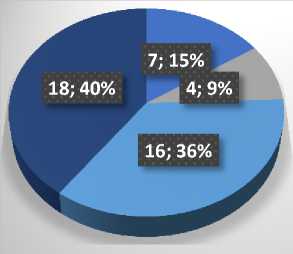
■ Production
■ Construction
■ Services
■ Maintenance
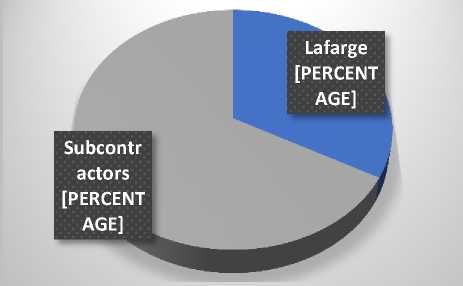
Source: Prepared by the researchers based on statistics from Lafarge M’Sila.
The first part of the chart shows that for every Lafarge employee, there are two subcontracted workers. This means that two-thirds of the workforce at the Hammam Dalaa Cement Plant in M’Sila are affiliated with subcontracting firms. This highlights the significant role subcontracted workers play in the operations of Lafarge Algeria.
The second part of the chart presents the distribution of subcontracting firms by area of specialization. The largest proportion, 40% , operate in maintenance (including heavy and light equipment). This is followed by services (such as cleaning, transportation, and catering), which account for 35.56% . Firms specializing in production (such as quarrying, kiln operation, and grinding) represent 15.56% , while those in construction make up 9% .
Together, firms working in maintenance and production account for more than half of all subcontracting firms ( 55.56% ). This suggests a high degree of trust and reliance by Lafarge M’Sila on its subcontractors in these key operational areas.
Subcontractor 1: Soltani Company
Soltani Construction Company was established in 2014. It is a medium-sized local firm employing approximately 57 workers , including 30 permanent and 27 temporary staff. The company operates in various areas of construction, including concrete works, electrical installations, painting, plumbing, and general building activities .
The following chart shows the growth in the number of workers employed by Soltani Company from the year of its first subcontracting agreement in 2014 until the end of 2020 .
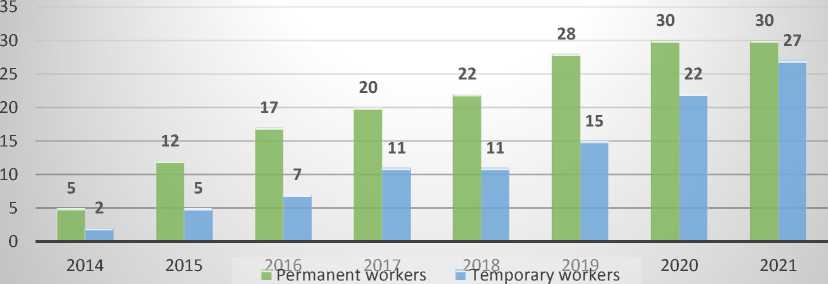
Figure 2: Workforce Growth at Soltani Company
Source: Prepared by the researchers based on statistics from Soltani Company.
At the time of its first subcontracting agreement with Lafarge Cement in M’Sila, Soltani Company was a microenterprise with no more than seven employees , including five permanent staff . Within one year, the company grew into a small enterprise with 17 employees , of whom 12 were permanent . Over the years, the company’s management succeeded in gaining the trust of Lafarge, which contributed to its expansion. By 2020 , Soltani had become a medium-sized firm with a workforce of 52 employees .
Subcontractor 2: Harizi Company
Harizi Company for Contracting and Public Works was founded in April 2007. It is now known as the Arab Company for Maintenance and Services. The firm operates in the fields of industrial maintenance and support services. It employs 372 subcontracted workers across Lafarge’s three plants in M’Sila, Mascara, and Biskra.
The following chart illustrates the growth in the number of employees at Harizi Company since 2007 .
Figure 3: Workforce Growth at Harizi Company.

-
■ Permanent workers ■ Temporary workers
Source: Prepared by the researchers based on data from Harizi Company.
The chart above shows the growth in workforce size and overall development of Harizi Company . It has now become a large enterprise with over 370 employees , including 235 permanent staff . In its early stages, the company was classified as small , employing 12 temporary workers only .
The turning point came five years after it began subcontracting work for Lafarge Cement in M’Sila. Specifically, in 2012 , the company reached 418 employees , including 400 permanent workers , mainly in cleaning and industrial maintenance .
Subcontractor 3: Achour Company
The company "SARL A.C.A ACHOUR" was established in 2011 . Its headquarters is located in Hammam Dalaa , in the province of M’Sila . The company employs more than 160 workers across its various branches. Of this workforce, 10% are executives , 30% are skilled workers , and 60% are technicians .
The following chart summarizes the workforce growth of Achour Company over the years.
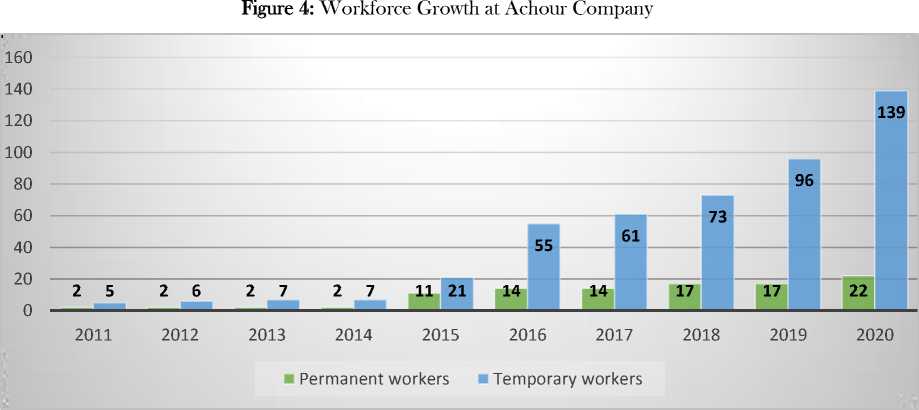
Source: Prepared by the researchers based on statistics from the Ashour Foundation.
The company began its operations as a subcontractor, acting as an intermediary for the transport of raw materials and ready-mixed cement. It was first established as a micro-enterprise with seven employees. In 2015, the company succeeded in obtaining a subcontracting contract in the field of truck maintenance. This contract enabled it to grow into a small enterprise with 32 employees, including 11 permanent staff.
By the end of 2015, the Ashour Foundation secured a major subcontracting contract in the quarrying sector. This contributed significantly to the increase in the number of employees, transforming it into a medium-sized enterprise with 69 workers. Currently, the company employs 161 workers, including 22 permanent staff.
4.2 Interview Analysis
The case study method primarily relies on linguistic descriptions. It seeks to document field observations using words rather than numbers (Ben Jakhdal, 2019). In our interview analysis, we adopted the traditional method. We compared the responses of the interviewees for each question to identify similar statements that could support the proposed hypotheses.
To enhance the traditional analysis, we may also use the qualitative analysis software Nvivo 11 . This tool allows us to quantify the managers’ responses, compare them, and derive some quantitative results. The program is based on four main approaches: the lexical approach, the thematic approach, the linguistic approach, and cognitive mapping.
First Approach: Lexical Analysis
This is the first approach used by the program. Its goal is to describe what the data discusses. It focuses on frequency counts (word repetition) and the similarity of terms used (Harizi, 2016). The following figure and table represent the most important outputs of the software for this approach.
Figure 05: Word cloud showing the most frequently used terms by the three managers collectively.
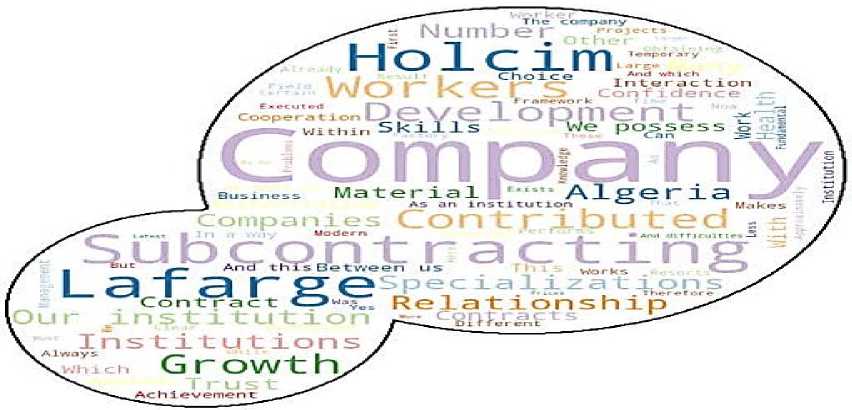
Source: Outputs from the Nvivo 11 software.
The previous figure displays the most frequently used terms. These typically appear in bold, such as subcontracting , Lafarge company , our institution , contributed , and Algeria . Other words tend to cluster near the center of the figure, including growth , cooperation , workers , development , number , and contract .
The following table presents the most frequently mentioned words across all three interviews. These terms have a direct relevance to the subject of our research.
Table 01: Most frequently repeated words in the three managers’ interviews.
Similar words percentage (%) repetition Words
|
subcontractor, executor |
2.65 |
111 |
Handling |
|
For the company, the company |
2.25 |
94 |
a company |
|
Our institution, institutions, institution |
2.15 |
90 |
Institutions |
|
Lafarge |
2.06 |
86 |
Lafarge |
|
Indeed, sure, right |
1.94 |
81 |
Yes |
|
growth, development, increase |
1.61 |
67 |
growth |
|
workers, workers |
1.21 |
51 |
workersus |
|
In Algeria |
1.19 |
50 |
Algeria |
|
contribute, improve, contribute |
0.93 |
39 |
Contributed |
|
Motives |
0.84 |
35 |
Motives |
|
Contracts, the contract |
0.79 |
33 |
a contract |
|
relationship, relationships |
0.72 |
30 |
relationship |
|
Their number, the number |
0.60 |
26 |
number |
|
By work, by work |
0.47 |
20 |
the job |
|
We get |
0.36 |
15 |
We own |
|
trust |
0.24 |
10 |
trust |
|
In cooperation |
0.14 |
6 |
cooperation |
Source: Prepared by the researchers based on outputs from Nvivo 11 .
The previous table presents the most frequently used words across the three interviews combined. Several terms clearly reflect the core focus of the study, such as subcontracting , company , Lafarge , and Algeria , which appeared 111, 94, 86, and 50 times respectively. Other words also support the study’s hypotheses, including our institution , growth , workers , contributed , and number , with frequencies of 90, 67, 51, 39, and 26 respectively.
Second Approach: Thematic Approach
The second approach in Nvivo relies on the coverage percentage of each node across the different sources or managers. Ideally, the node coverage should be balanced. That means each interview section should reflect the thematic node it corresponds to. The following figure illustrates the coverage percentage for each node across the three managers.
Figure 06: Coverage percentage of thematic nodes across the three managers.

Coverage rate

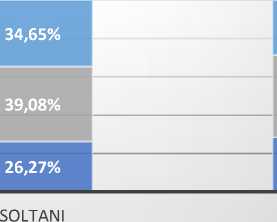

■ Node general subcontractors ■ Node subcontractors at Lafarge Node Growth of subcontractors
Source: repared by the researchers based on outputs from Nvivo 11 .
The interview guide consisted of 13 questions. This means that the average coverage rate for a node made up of 4 questions is 30.77%, while that for a node containing 5 questions is 38.46%. These figures are close to the actual coverage rates shown in the previous figure. This suggests that the interviews were balanced and that the nodes accurately represented the interview themes. Such consistency adds credibility to the study we are conducting.
Third Approach: Linguistic Approach
If the aim of using Nvivo is to quantify qualitative data, then the linguistic approach is the most effective among the four. It allows for the calculation of textual similarity using Pearson’s correlation coefficient. This can be applied either to compare the three sources or to measure similarity between nodes. The results are expressed as percentages, which provide a clear and measurable indication of similarity or correlation.
The following two tables present the correlation coefficients: the first between the managers, and the second between the thematic nodes.
Table 02: Correlation coefficients between the three managers.
Source A
Source B
Coefficient de corrélation de Pearson
|
Interview Ashour |
Interview Harizi |
0,89986 |
|
Interview Soltani |
Interview Harizi |
0,88091 |
|
Interview Ashour |
Interview Soltani |
0,87526 |
|
Average |
0,88534 |
|
Source: Outputs from Nvivo 11 .
The Pearson correlation coefficient, or textual similarity rate, between the managers reached 0.88. This is a very strong value, indicating a high level of similarity in responses. It suggests that the managers had sufficient knowledge of the study topic. It also reflects the appropriateness of the purposive sampling used in the research.
It is also worth noting that the highest correlation was found between the Ashour and Harizi institutions. These are the two larger companies, employing 161 and 372 workers respectively, with 11 and 14 years of experience. In contrast, the Sultani institution, with only 52 workers and 7 years of experience, showed a lower level of similarity.
Table 03: Correlation coefficients between the three thematic nodes.
Coefficient de corrélation de
Source A Source B
Pearson
|
Node Growth of subcontractors |
Node subcontractors at Lafarge |
0,83 |
|
Node subcontractors at Lafarge |
Node general subcontractors |
0,77 |
|
Node Growth of subcontractors |
Node general subcontractors |
0,67 |
|
Average |
0,76 |
|
Source: Outputs from Nvivo 11 .
The previous table shows the Pearson correlation coefficient between the nodes across all interviews. The correlation rate reached 0.76, which is considered strong. This indicates a significant relationship among the nodes and suggests that the interview guide was well-balanced in its thematic structure.
The same table also shows that the highest correlation was between the nodes Growth of subcontracting firms and Subcontracting at Lafarge , which reached 0.83. This result supports the validity of the first hypothesis. On the other hand, the lowest correlation was found between the nodes Growth of subcontracting firms and Subcontracting in general , with a value of 0.67.
Fourth Approach: Cognitive Mapping
Cognitive maps aim to organize a specific idea by presenting a visual diagram of the concepts and the relationships between them at a given point in time. These maps allow us to visualize the complexity and interconnection of a variable or term with other related terms at a specific moment.
The cognitive map for the term growth illustrates its connection with several concepts, such as: number ofworkers , contribution ofsubcontracting activity , Lafarge company , growth ofour institution , and local firms .
Figure (08): Knowledge map of the study.
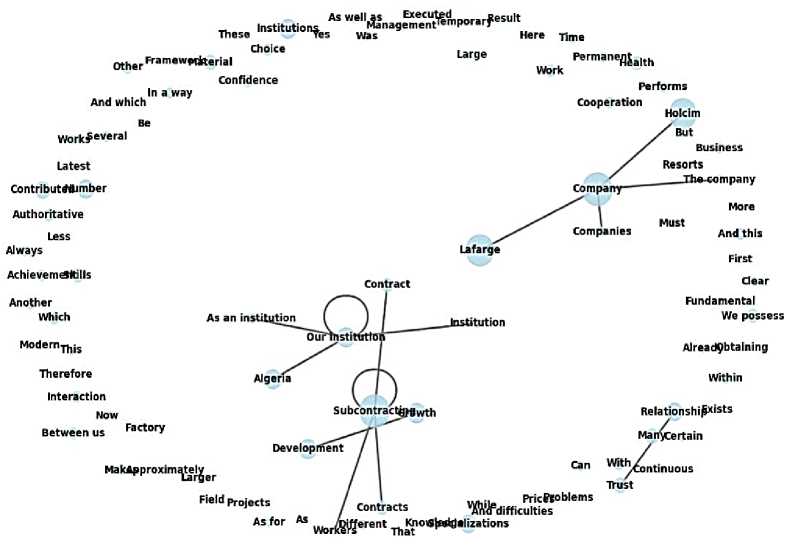
Source: Outputs of Nvivo 11 software.
2.4. Hypotheses Testing:
To verify the validity of the hypotheses proposed at the beginning of this study, we utilized the results from both traditional analysis and the analysis conducted using Nvivo 11 software. This involved semi-structured interviews, which served as the primary data collection tool. Additionally, we incorporated findings from document analysis and the researcher’s field observations. The following table summarizes the extent to which the hypotheses were confirmed by consolidating all results:
|
Verification degree |
Results of analysis: interviews and documents |
General approaches For each hypothesis |
0.90). Very good;
|
■ Interviews: It indicates good sample selection and good preparation of the interview guide. |
|
|
very good. |
Charts showing the growth in the number of workers in the sample subcontracting companies since the first subcontracting contract with Lafarge Algeria.
Repetition of key terms (handling, contributed, growth, our organization, number, Lafarge, workers); The coverage ratio of the second node (39.08 – 43.03) and the third node (28.59 – 34.65); The Parson's coefficient of textual similarity between the second and third nodes (0.83) is very good; Cognitive map for the term "growth".
Yes, the number of our employees is increasing from year to year; The sure thing is the growth of our organization and the growth of our number of employees; Lafarge has certainly contributed to the growth of our workforce; Lafarge has contributed significantly to the growth of our organization. |
"Lafarge contributesFor cement in M'SilaIn the growth of handling institutions Local Study sample"
Strong link between Lafarge's subcontracting nodes and the growth of subcontracting companies. |
|
good. |
Lafarge is using the outsourcing option to focus on its core business; We can get things done with higher quality, lower cost, and on time; We are proud that we have been able to build a group of knowledge and experiences in our field, We are consulted regarding the completion of some work; Respects its obligations towards its subcontracting institutions, such as billing periods; Fulfilling its financial obligations towards the handling institutions; Provide us with the necessary support to overcome problems and difficulties. |
" Lafarge takes overFor cement in M'SilaGreat interest in handling institutionsLocalStudy sample.
There is a high degree of consistency between managers' responses regarding the importance of handling institutions. |
good.
-
■ Similar and meaningful words and phrases:
What helped us gain the trust of Lafarge's managers?
Trust in our institution has contributed to the activation of cooperation between us;
Developing our relationship into one based on trust and cooperation;
Through fair competition between all its subcontracting institutions;
This is what helped us gain the trust of Lafarge's management. Developing a relationship of trust between us has contributed to obtaining many projects;
The mutual trust between us has contributed to us being awarded many projects;
Some activities are awarded to trusted subcontracting institutions;
We aspire to exploit this trust in the growth of our organization..
-
■ The third hypothesis:
" Trust contributes to LafargeFor cement in M'SilaAnd its subcontracting institutions in the growth of the latter.
-
■ Comment:
Their answers are very similar about the relationship between trust and the growth of their organizations.
Source: Prepared by the researchers based on (Harizi, 2016, p. 149).
The table demonstrates a clear alignment between the interview data and the analytical documents that support the study’s hypotheses. This reflects a high level of quality in the methods used for data collection and analysis.
Hypothesis One:
“Lafarge Cement Company in M’sila contributes to the growth of local subcontracting firms within the study sample.”
The interview results show a strong and clear link between subcontracting and the growth of subcontracting firms. Key terms such as subcontracting , growth , and workers appeared frequently and consistently across all participants. This indicates a deep and shared understanding of the topic. The analysis of documents also confirms a steady increase in the number of workers within the subcontracting firms included in the study. This is further supported by the high textual similarity index (0.87–0.90) and by cognitive maps related to the concept of growth. Together, these indicators reflect a “very strong” validation of the hypothesis and support the existence of a direct relationship between the role of Lafarge and the growth of local subcontracting firms.
Hypothesis Two:
“Lafarge Cement Company in M’sila shows strong interest in the local subcontracting firms within the study sample.”
The data reveals a high level of consistency in the managers’ responses regarding the importance of subcontracting firms. This is reinforced by document analysis, which highlights significant reliance on these firms across various areas of the plant, particularly in production and maintenance. Participant statements such as “focusing on core tasks” , “fulfilling financial obligations” , and “providing support to overcome challenges” reflect the level of support and attention offered by the company. These results indicate a solid validation of the second hypothesis and highlight Lafarge’s central role in supporting subcontracting firms.
Hypothesis Three:
“Mutual trust between Lafarge Cement Company in M’sila and its subcontracting firms contributes to the growth of the latter.”
The responses show strong agreement on the importance of trust as a key factor in building cooperation and achieving sustainable growth. Phrases such as “earning trust” , “developing the relationship into one based on cooperation” , and “securing multiple projects through trust” were frequently mentioned. These findings confirm the positive impact of trust-based relationships between the company and its subcontractors. The evidence indicates that trust is not only a psychological factor but also translates into real development opportunities for the firms.
. 5. Conclusion
This study aims to assess the contribution of the multinational company Lafarge to the growth of local subcontracting firms in Algeria. It focuses on how Lafarge influences the operational and managerial capabilities of these firms. The study is based on a purposive sample of three local subcontractors operating at the Lafarge Cement M’sila (LCM) plant. A qualitative methodology was adopted, incorporating field observation, document analysis, and semi-structured interviews. The data were analyzed using the Nvivo 11 software.
Although this is a qualitative case study, and its findings may not be broadly generalizable, the study provides valuable insights into how multinational corporations and industrial subcontracting can support the development of local subcontractors. The findings reveal that Lafarge Cement M’sila continuously works to support the growth of subcontracting firms by mobilizing its resources and available capacities. The company shows strong interest in these firms, viewing them as key partners in reducing operational costs and improving efficiency.
The study also shows that the growth and expansion of subcontracting firms have directly enabled Lafarge to focus more effectively on its core tasks, such as improving productivity and enhancing its competitiveness in the market. This dynamic has allowed the company to delegate routine and non-core activities to subcontractors efficiently, resulting in better resource allocation and a stronger focus on innovation and development. This shift would not have been possible without a relationship built on trust and cooperation between Lafarge and its subcontractors. That trust has become a strong foundation for sustaining and enhancing the long-term partnership.
Furthermore, the evolving environment within Lafarge continues to offer new opportunities for subcontracting firms, including the potential to enter new areas of work and expand their service offerings. These opportunities have allowed local firms to strengthen their capabilities and diversify their activities, thereby increasing their adaptability and resilience in a changing market. This expansion has had a positive impact on both the volume of operations and the quality of services provided by subcontractors.
On another front, Lafarge’s commitment to honoring its financial obligations toward subcontractors has played a crucial role in creating a stable working environment. Timely financial commitment is a key factor in building trust and confidence among local firms. It has enabled these companies to plan their finances more effectively and implement their projects without disruption, contributing to more sustainable growth.
In addition, Lafarge has played an active and supportive role when subcontracting firms faced operational or managerial challenges. Whether through technical, operational, or even advisory support, this ongoing assistance has not only helped resolve immediate issues but has also contributed to building the internal capabilities of these local firms. This has added significant value to the subcontracting partnership and confirmed its effectiveness in achieving balanced and sustainable development.
Based on the findings, the study recommends that the Ministry of Industry develop effective mechanisms to encourage the role of multinational companies in supporting local subcontracting firms. This requires clear legislative and regulatory frameworks, including tax incentives and technical support programs to empower these firms. The study also proposes the establishment of an active communication platform involving the Ministry, multinational companies, and local firms. This would facilitate the exchange of information, monitor subcontracting contracts, and promote training and capacity-building in management and technical areas to ensure long-term benefits from such partnerships.
For Lafarge Cement M’sila specifically, the study recommends strengthening its strategic partnership programs by expanding cooperation with subcontractors through continuous professional development agreements and regular administrative and technical support. It also suggests improving monitoring and evaluation mechanisms by using clear performance indicators to ensure service quality and subcontractor accountability. Timely payment of financial dues is vital in reinforcing financial trust and stability, which are essential for subcontractor growth.
As for local subcontractors, the study emphasizes the importance of adopting a culture of quality and professionalism. This includes implementing quality management standards and investing in the development of both technical and managerial staff. Building long-term trust with Lafarge should be based on transparency, contractual commitment, and continuous communication. It is also recommended that these firms diversify their services and expand into related sectors to enhance competitiveness. Financial and administrative planning must be a priority to ensure sustained growth and minimize operational risks.
These recommendations align with global literature and studies that highlight the importance of strategic partnerships based on trust and cooperation in achieving sustainable economic development. They also underscore the critical role of multinational companies in strengthening the technical and managerial capacities of local firms. This, in turn, contributes to creating a strong competitive environment that enhances the performance of local firms in both domestic and international markets.

